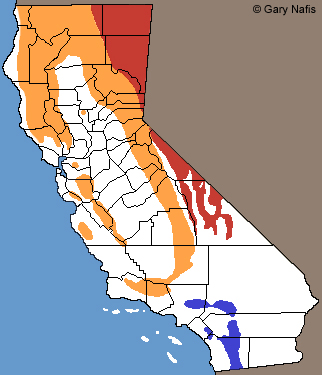|
 |
| Gravid adult female, 6,200 ft., Sierra Nevada Mountains, Tuolumne County |
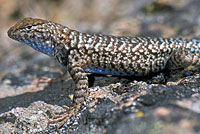 |
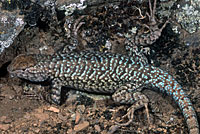 |
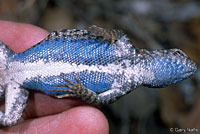 |
 |
| Adult Male, 3,800 ft.Contra Costa County |
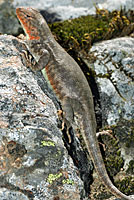 |
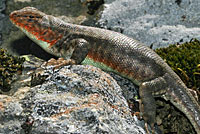 |
 |
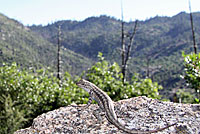 |
| Gravid adult female in June, 3,800 ft. Contra Costa County |
Adult, 6,200 ft., Sierra Nevada Mountains, Tulare County |
 |
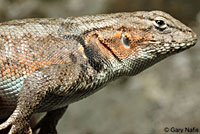 |
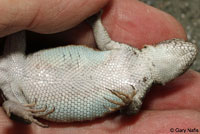 |
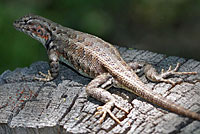 |
| Gravid adult female in June, 6,200 ft.,Sierra Nevada Mountains, Tuolumne County |
Adult, Breckenridge Mountain
Kern County |
 |
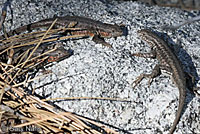 |
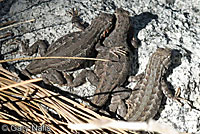 |
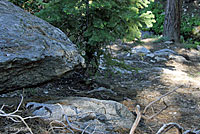 |
| A family group at 7,200 ft. in the Sierra Nevada Mountains, Tulare County, in late June including two gravid females in breeding color and one male. |
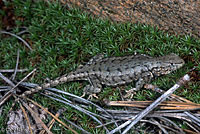 |
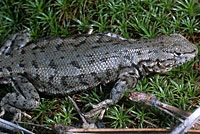 |
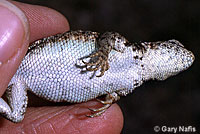 |
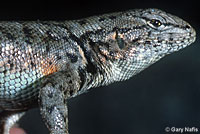 |
| Adult female, 6,400 ft. Sierra Nevada Mountains, Calaveras County |
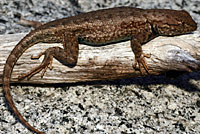 |
 |
 |
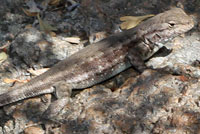 |
| Adult male, 6,400 ft. Sierra Nevada Mountains, Calaveras County |
Adult, 5,500 ft., Siskiyou County |
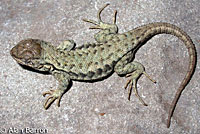 |
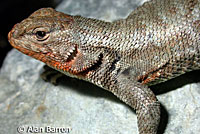 |
 |
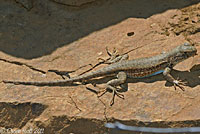 |
| Gravid Adult female showing breeding coloration, Del Norte County © Alan Barron |
Adult, 1,400 ft. Santa Cruz Mountains, Santa Clara County © Owen Holt |
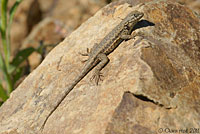 |
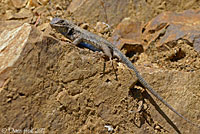 |
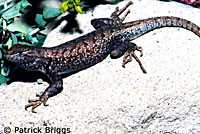 |
 |
| Adult, 1,400 ft. Santa Cruz Mountains, Santa Clara County © Owen Holt |
Adult, 1,400 ft. Santa Cruz Mountains, Santa Clara County © Owen Holt |
Adult male, Ventura County
© Patrick Briggs |
Adult female, Ventura County
© Patrick Briggs |
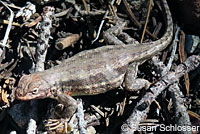 |
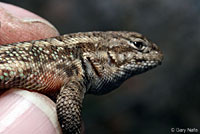 |
 |
|
Gravid adult female, approx. 6,800 ft. elevation (2,072 m) Trinity County
© Susan Schlosser |
Close-up (of a different subspecies) that shows the orange coloring behind the front legs and the black mark in front of the front legs that is usually found on Sagebrush Lizards. |
Sagebrush Lizards have overlapping scales with sharp spines on the back. |
|
| |
|
|
|
| Juveniles |
 |
 |
 |
|
Juvenile, Mariposa County
© Andre Giraldi |
Juvenile, Contra Costa County |
Juvenile, 2,400 ft. Santa Cruz Mountains, Santa Clara County
© Owen Holt |
|
| |
|
|
|
| Habitat |
 |
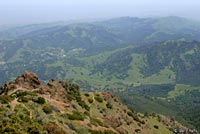 |
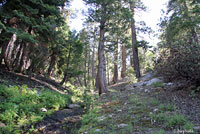 |
 |
| Habitat, forest clearing, 5,500 ft., Siskiyou County |
Habitat, Contra Costa County |
Habitat, 7,200 ft. Tulare County |
Habitat, 6,800 ft. Breckenridge Mountain, Kern County |
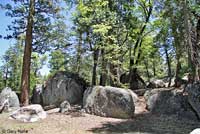 |
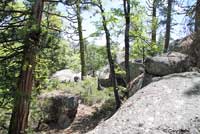 |
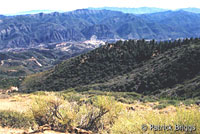 |
 |
| Habitat, 6,200 ft., Tuolumne County |
Habitat, 6,200 ft., Tuolumne County |
Habitat, Ventura County © Patrick Briggs |
Habitat, 6,400 ft. Calaveras County |
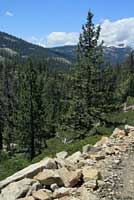 |
|
|
|
| Habitat, 8,000 ft. Alpine County |
|
|
|
| |
|
|
|
| Short Videos |
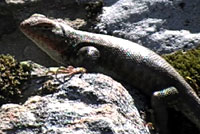 |
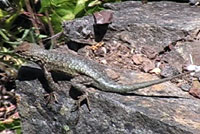 |
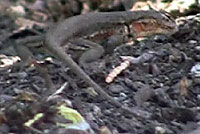 |
|
| This movie starts just after a male Western Sagebrush Lizard ran up the face of a large a rock outcrop and tackled a huge female who is full of eggs and showing her orange breeding color. He continues to harass her and she moves slowly with her body and her tail elevated defensively. Then he settles in on a ledge above her while she rests. (She occasionally leaped after flying insects which landed nearby, but I could not get that on video.) |
A male Western Sagebrush Lizard in Contra Costa County runs between rocks, stopping to do his push-up display. This is the same male just before he ran up the rock and chased the female in the previous video. |
I followed a sagebrush lizard around one morning at my campsite with a video camera as it crawled over a large fallen tree, then foraged around eating small insects. |
|
 |
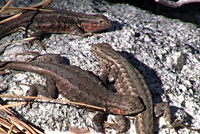 |
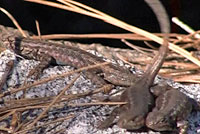 |
|
| These three short videos show some interactions between a male and two gravid female Western Sagebrush Lizards on an afternoon in late June in the Sierra Nevada Mountains in Tulare County. In the first video, they are separated but the male jumps down to join a female and the third comes down from her rock, then as their shade disappears, they move into a sunny patch only a few feet away from the camera to bask. The other two videos show lots of push-ups, tail elevating, shuffling around, and even what looks like snuggling. |
|
|
|
| Description |
| |
| Size |
1 7/8 - 3 1/2 inches long from snout to vent (4.7 - 8.9 cm). (Stebbins 2003)
|
| Appearance |
A small lizard with small keeled and pointed scales overlapping on the upper surfaces of the body and limbs.
These scales are not as large as they are on other lizards of the genus Sceloporus.
The gular fold is incomplete.
The scales on the back of the thigh are mostly granular, not keeled (as they are on the Western Fence Lizard.) |
| Color and Pattern |
Color is gray or brown with dark blotches or irregular bands on the body and tail.
Stripes on the sides, visible on other subspecies of Sceloporus graciosus, are not distinct on this subspecies, being reduced to rows of blotches or only partly connected blotches.
There is usually a bar of black on the shoulder in front of the front legs and rusty coloring on the armpits behind the front legs and sometimes on the sides of the body and the neck.
Unlike the Western Fence Lizard - Sceloporus occidentalis, there is normally no yellow coloring on the rear of the limbs. |
| Male / Female Differences |
Males have a patch of blue color on each side of the belly and on the throat.
The blue throat and belly patches are separated by white.
Male post-anal scales are enlarged, and the base of the tail is broader than on the female.
The throat is light blue mottled with white spots.
Sometimes the blue patch is reduced or even absent.
Some males may develop bright orange breeding coloring.
Females have little or no blue on the belly.
When breeding, females may develop orange coloring on the sides and neck and yellow underneath. |
| Young |
| Young lizards have little or no blue on the belly. |
| |
| Differences Between the Three Forms of Sagebrush Lizards found in California |
|
| Differences Between Sagebrush Lizards and the Similar Western Fence Lizard in California |
| |
| Life History and Behavior |
Activity |
Diurnal.
Active spring through fall.
Hibernates during winter.
A good climber and jumper, able to quickly jump from rock to rock.
Lives mostly on the ground near bushes, logs, rocks, or brush piles.
Often observed basking on rocks and logs.
|
| Territoriality |
| Males defend their territory and try to attract females with a push-up display that exposes the blue throat and ventral colors. Sometimes the tail is also held erect. |
| Defense |
Escapes danger by running into rocks, rodent burrows, or brush or climbs up trees or rock outcrops.
The tail can break off easily, but it will grow back. The detached tail wriggles on the ground which can distract a predator from the body of the lizard allowing it time to escape.
More information about tail loss and regeneration. |
| Diet and Feeding |
| Eats a variety of small invertebrates, including ants, termites, grasshoppers, flies, spiders, and beetles. |
| Reproduction |
Females lay 1 or 2 clutches of 2 - 10 eggs from June to August.
|
| Habitat |
Lives in sagebrush and other types of shrublands such as manzanita and ceanothus, as well as open pine and Douglas Fir forests, mainly in the mountains (usually at higher elevations than the Western Fence Lizard but they coexist at lower elevations). In coastal redwood forests, lives along river bottoms. Prefers open areas with scattered low bushes and lots of sun.
|
| Geographical Range |
This subspecies ranges west of the Great Basin desert in California, south throughout the Sierra Nevada and Tehachapi mountains, the inner Coast Ranges and Diablo Range, and along the north coast and northern mountain ranges, continuing north into southern Oregon. Populations also occur in the Sutter Buttes and in the Santa Cruz Mountains.
The species Sceloporus graciosus occurs in California, Eastern oregon, central Washington, southern Idaho parts of Montana and North Dakota, in much of Wyoming, Utah, western Colorado, northwest New Mexico, northern Arizona, and in the Sierra San Pedro Martir of northern Baja California.
|
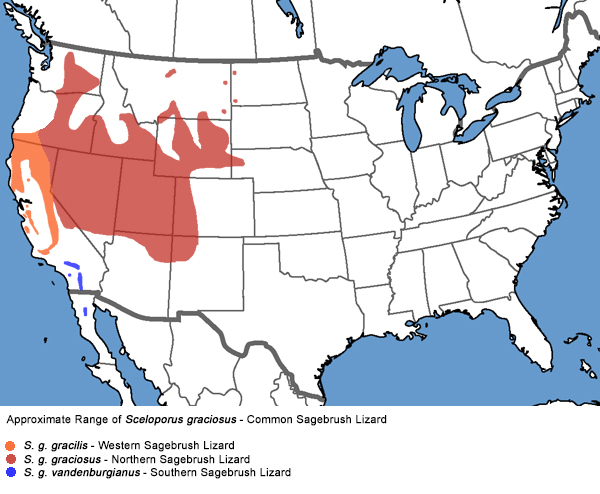 |
| Elevational Range |
The species Sceloporus graciosus is found at elevations of
500 ft. to about 10,500 ft. (150 - 3,200 m) (Stebbins 2003).
|
| Notes on Taxonomy |
In 2025 I changed S. g. vandenburgianus to the full species S. vandenburgianus. based on a similar arrangement adopted by several other authorities, including iNaturalist, Wikipedia, the Reptile Database, Stebbins & McGinnis (201)2, and Hansen and Shedd (2025). Hansen and Shedd show this taxonomical note: "Using morphological and molecular data for Sceloporus, Wiens and Reeder (1997) presented results of an integrative analysis, in which they recognized three species making up the graciosus group (S. arenicolus, S. graciosus, and S. vandenburgianus), although some later guides continued to regard these as conspecific. Based on the consensus of various recent studies (Wiens et al. 2010; Wiens et al. 2013; Leaché et al. 2016), we recognize S. vandenburgianus as species distinct from S. graciosus and acknowledge that this group needs taxonomic revision (Frabotta 2002; Chan et al. 2013)."
-----------------------------------------------------------------------------------------------------------------------------------------------------------------------------------------------------------------------------
Three subspecies of Sceloporus graciosus have been recognized in California:
Sceloporus graciosus gracilis - Western Sagebrush Lizard,
Sceloporus graciosus graciosus - Northern Sagebrush Lizard, and
Sceloporus graciosus vandenburgianus - Southern Sagebrush Lizard.
Sceloporus graciosus vandenburgianus has been described as a unique species, Sceloporus vandenburgianus.
-----------------------------------------------------------------------------------------------------------------------------------------------------------------------------------------------------------------------------
"Chan et al. (2013, Zootaxa 3664: 312–320) found that the currently recognized subspecies of S. graciosus are incongruent with mitochondrial haplotype clades, which often exhibit relatively deep divergences between geographically proximate samples, and that S. graciosus is paraphyletic relative to S. arenicolus. Although these findings suggest that S. graciosus is in need of taxonomic revision, those authors did not propose any taxonomic changes."
(SSAR Herpetological Circular No. 43, 2017)
-----------------------------------------------------------------------------------------------------------------------------------------------------------------------------------------------------------------------------
In 1991, Collins (1991,Herpetol. Rev. 22: 42–43) proposed recognizing S. g. vandenburgianus as a full species, - Sceloporus vandenburgianus. In 1997, Wiens & Reeder (1997 Herpetological Monographs 11: 1-101) followed Collins’ proposal but pointed out the morphological similarity and geographic proximity of S. vandenburgianus to populations of Sceloporus graciosus gracilis. In response, many researchers are awaiting further studies before elevating the taxon to full species.
-----------------------------------------------------------------------------------------------------------------------------------------------------------------------------------------------------------------------------
"This subspecies, as currently circumscribed, is incongruent with a mitochondrial haplotype phylogeny (see Chan et al. 2013, Zootaxa 3664: 312–320)."
(Nicholson, K. E. (ed.). 2025 SSAR Scientific and Standard English Names List)
-----------------------------------------------------------------------------------------------------------------------------------------------------------------------------------------------------------------------------
Alternate and Previous Names (Synonyms)
Sceloporus graciosus gracilis - Western Sagebrush Lizard (Stebbins 1985)
Sceloporus graciosus graciosus - Northern Sagebrush Lizard (Stebbins 1966)
Sceloporus graciosus gracilis - Northern Mountain Lizard (Smith 1946)
Sceloporus graciosus graciosus - Mountain Lizard (Sceloporus consobrinus, Sceloporus consobrinus gratiosus; New Mexican Alligator Lizard; Sage-brush Swift,part; Fence Lizard, part; Marcy's Alligator Lizard) (Grinnell and Camp 1917)
|
| Conservation Issues (Conservation Status) |
| None |
|
|
Taxonomy |
| Family |
Phrynosomatidae |
Zebra-tailed, Earless, Fringe-toed, Spiny, Tree, Side-blotched, and Horned Lizards |
Fitzinger, 1843 |
| Genus |
Sceloporus |
Spiny Lizards |
Wiegmann, 1828 |
| Species |
graciosus |
Common Sagebrush Lizard |
Baird and Girard, 1852 |
Subspecies
|
gracilis |
Western Sagebrush Lizard |
Baird and Girard, 1852 |
|
Original Description |
Sceloporus graciosus - Baird and Girard, 1852 - Proc. Acad. Nat. Sci. Philadelphia, Vol. 6, p. 69
Sceloporus graciosus gracilis - Baird & Girard, 1852 - Proc. Acad. Nat Sci. Philadelphia, Vol. 6, 1852, p. 175.
from Original Description Citations for the Reptiles and Amphibians of North America © Ellin Beltz
|
|
Meaning of the Scientific Name |
Sceloporus - Greek - skelos = leg + porus = pore or opening - refers to the femoral pores on hind legs
graciosus - Latin = graceful - "This small and graceful species..."
gracilis - Latin = slender
from Scientific and Common Names of the Reptiles and Amphibians of North America - Explained © Ellin Beltz
|
|
Related or Similar California Lizards |
Sceloporus graciosus graciosus - Northern Sagebrush Lizard
Sceloporus vandenburgianus - Southern Sagebrush Lizard
Uta stansburiana - Common Side-blotched Lizard
Sceloporus occidentalis - Western Fence Lizard
Sceloporus magister uniformis - Northern Desert Spiny Lizard
|
|
More Information and References |
California Department of Fish and Wildlife
Hansen, Robert W. and Shedd, Jackson D. California Amphibians and Reptiles. (Princeton Field Guides.) Princeton University Press, 2025.
Stebbins, Robert C., and McGinnis, Samuel M. Field Guide to Amphibians and Reptiles of California: Revised Edition (California Natural History Guides) University of California Press, 2012.
Stebbins, Robert C. California Amphibians and Reptiles. The University of California Press, 1972.
Flaxington, William C. Amphibians and Reptiles of California: Field Observations, Distribution, and Natural History. Fieldnotes Press, Anaheim, California, 2021.
Nicholson, K. E. (ed.). 2025. Scientific and Standard English Names of Amphibians and Reptiles of North America North of Mexico, with Comments Regarding Confidence in Our Understanding. Ninth Edition. Society for the Study of Amphibians and Reptiles. [SSAR] 87pp.
Samuel M. McGinnis and Robert C. Stebbins. Peterson Field Guide to Western Reptiles & Amphibians. 4th Edition. Houghton Mifflin Harcourt Publishing Company, 2018.
Stebbins, Robert C. A Field Guide to Western Reptiles and Amphibians. 3rd Edition. Houghton Mifflin Company, 2003.
Behler, John L., and F. Wayne King. The Audubon Society Field Guide to North American Reptiles and Amphibians. Alfred A. Knopf, 1992.
Robert Powell, Roger Conant, and Joseph T. Collins. Peterson Field Guide to Reptiles and Amphibians of Eastern and Central North America. Fourth Edition. Houghton Mifflin Harcourt, 2016.
Powell, Robert., Joseph T. Collins, and Errol D. Hooper Jr. A Key to Amphibians and Reptiles of the Continental United States and Canada. The University Press of Kansas, 1998.
Bartlett, R. D. & Patricia P. Bartlett. Guide and Reference to the Turtles and Lizards of Western North America (North of Mexico) and Hawaii. University Press of Florida, 2009.
Jones, Lawrence, Rob Lovich, editors. Lizards of the American Southwest: A Photographic Field Guide. Rio Nuevo Publishers, 2009.
Smith, Hobart M. Handbook of Lizards, Lizards of the United States and of Canada. Cornell University Press, 1946.
Taylor, Emily. California Lizards and How to Find Them. Heyday, Berkeley, California. 2025.
Brown et. al. Reptiles of Washington and Oregon. Seattle Audubon Society,1995.
Nussbaum, R. A., E. D. Brodie Jr., and R. M. Storm. Amphibians and Reptiles of the Pacific Northwest. Moscow,
Idaho: University Press of Idaho, 1983.
St. John, Alan D. Reptiles of the Northwest: Alaska to California; Rockies to the Coast. 2nd Edition - Revised & Updated. Lone Pine Publishing, 2021.
Joseph Grinnell and Charles Lewis Camp. A Distributional List of the Amphibians and Reptiles of California. University of California Publications in Zoology Vol. 17, No. 10, pp. 127-208. July 11, 1917.
|
|
|
The following conservation status listings for this animal are taken from the July 2025 State of California Special Animals List and the July 2025 Federally Listed Endangered and Threatened Animals of California list (unless indicated otherwise below.) Both lists are produced by multiple agencies every year, and sometimes more than once per year, so the conservation status listing information found below might not be from the most recent lists, but they don't change a great deal from year to year.. To make sure you are seeing the most recent listings, go to this California Department of Fish and Wildlife web page where you can search for and download both lists:
https://www.wildlife.ca.gov/Data/CNDDB/Plants-and-Animals.
A detailed explanation of the meaning of the status listing symbols can be found at the beginning of the two lists. For quick reference, I have included them on my Special Status Information page.
If no status is listed here, the animal is not included on either list. This most likely indicates that there are no serious conservation concerns for the animal. To find out more about an animal's status you can also go to the NatureServe and IUCN websites to check their rankings.
Check the current California Department of Fish and Wildlife sport fishing regulations to find out if this animal can be legally pursued and handled or collected with possession of a current fishing license. You can also look at the summary of the sport fishing regulations as they apply only to reptiles and amphibians that has been made for this website.
This animal is not included on the Special Animals List, which indicates that there are no significant conservation concerns for it in California.
|
| Organization |
Status Listing |
Notes |
| NatureServe Global Ranking |
|
|
| NatureServe State Ranking |
|
|
| U.S. Endangered Species Act (ESA) |
None |
|
| California Endangered Species Act (CESA) |
None |
|
| California Department of Fish and Wildlife |
None |
|
| Bureau of Land Management |
None |
|
| USDA Forest Service |
None |
|
| IUCN |
|
|
|
|
